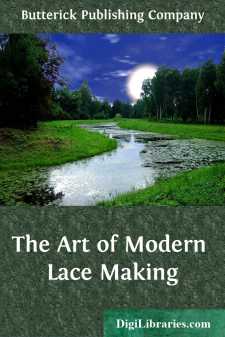Categories
- Antiques & Collectibles 13
- Architecture 36
- Art 48
- Bibles 22
- Biography & Autobiography 813
- Body, Mind & Spirit 142
- Business & Economics 28
- Children's Books 15
- Children's Fiction 12
- Computers 4
- Cooking 94
- Crafts & Hobbies 4
- Drama 346
- Education 46
- Family & Relationships 57
- Fiction 11829
- Games 19
- Gardening 17
- Health & Fitness 34
- History 1377
- House & Home 1
- Humor 147
- Juvenile Fiction 1873
- Juvenile Nonfiction 202
- Language Arts & Disciplines 88
- Law 16
- Literary Collections 686
- Literary Criticism 179
- Mathematics 13
- Medical 41
- Music 40
- Nature 179
- Non-Classifiable 1768
- Performing Arts 7
- Periodicals 1453
- Philosophy 64
- Photography 2
- Poetry 896
- Political Science 203
- Psychology 42
- Reference 154
- Religion 513
- Science 126
- Self-Help 84
- Social Science 81
- Sports & Recreation 34
- Study Aids 3
- Technology & Engineering 59
- Transportation 23
- Travel 463
- True Crime 29
The Art of Modern Lace Making
Categories:
Description:
Excerpt
ANCIENT AND MODERN METHODS.
The art of making lace in one form or another has existed from the earliest ages. There are Scriptural references to various web-like fabrics, which were of rude construction, no doubt, but whose general characteristics were identical with those productions of modern skill which have for centuries been known as lace. Homer and other ancient writers constantly mention net-works of fancifully embroidered materials; gold thread-work was known to the Romans; and as Egyptian robes of state are depicted upon the tombs of the earlier dynasties as being fashioned from a looped net-work or crochet, it is probable that the Israelites learned the art from the Egyptians. Museums contain specimens of lace dating back to periods that to us of the present day seem mere dreams of reigns and eras, and history includes a scattered literature of lace which proves that the art must have been practised almost from the beginning.
Up to the Sixteenth Century, however, open work embroidery was the favorite decoration, and from it the tangible origin of lace seems derived. During the Renaissance period the first book of embroidery patterns and lace-work appeared. The earliest volume bearing a date was printed at Cologne in 1527; and it was during the reign of Richard III. of England that the word lace was first used in the descriptions of the royal wardrobe.
At first the best known laces were those of Venice, Milan and Genoa. The Italians claim the invention of point or needle-made lace; but the Venetian point is now a product of the past, and England and France supply most of the fine laces of the present time.
Lace-makers in the various European countries are trained to the work from childhood; but it is said that the makers of Honiton lace, the fabric of which Queen Victoria's wedding gown was made, are rapidly decreasing in numbers, so that there are few persons now living who understand the construction of this exquisite "pillow" lace. The costly point and Honiton and the dainty Mechlin and Valenciennes of bygone days can only be produced by trained lace-workers, whose skilful fingers weave bobbins of cobweb-like thread to and fro over the "pillow" necessary to antique methods; and for this reason fine lace-making is practically beyond the skill of the amateur. Besides, some of the threads in the very filmy laces are so fine that they cannot be successfully manipulated except in a moist atmosphere, such as that of Great Britain; and even there some of the more exquisite specimens must perforce be made in underground rooms, since it is only there that the proper degree of moisture can be obtained. In dry climates these gossamer-like threads would roughen and break at almost the slightest touch.
Referring to the known origin of some of the earlier laces, a writer upon the subject says:
"They say it was a woman, Barbara Uttmann, who invented pillow lace in the 16th century. Women have ever been patrons of lace-making. Victoria has kept the Honiton laces in fashion, and it was the Duchess of Argyle who introduced lace-making in Scotland. The Countess of Erne and Lady Denny and Lady Bingham began it in Ireland, and Lady De Vere gave her own Brussels point for patterns when the first Irish point was made at Curragh. It was Elizabeth of Denmark who introduced lace-making in that country, and the Archduchess Sophia who started lace schools in Bohemia. "Now at least I can have laces," said Anne of Austria, when Louis XIII., her husband died, and her court was famous for its cleanliness and its Spanish point. Colbert had three women as coadjutors when he started lace-making in France. It was because Josephine loved point d'Alençon that Napoleon revived it. Eugenie spent $5,000 for a single dress flounce, and had $1,000,000 in fine laces."
Victoria's favorite, Honiton, is not considered a particularly beautiful lace, although its weaving is so tedious and difficult. "Real Honiton laces," so says an authority, "are made up of bits and bits fashioned by many different women in their own little cottages—here a leaf, there a flower, slowly woven through the long, weary days, only to be united afterward in the precious web by other workers who never saw its beginning. There is a pretty lesson in the thought that to the perfection of each of these little pieces the beauty of the whole is due—that the rose or leaf some humble peasant woman wrought carefully, helps to make the fabric worthy the adorning of a queen or the decoration of an altar, even as the sweetness and patient perfection in any life makes all living more worthy and noble. A single flower upon which taste and fancy were lavished, and which sustained and deft labor brought to perfection, represents the lives of many diligent women workers.
It has become so much the fashion to worship all things ancient that most lovers of fine lace would prefer to have it a century old; and yet there never was a time when laces were more beautiful, more artistic and more unique in design than just at the present day; for modern laces preserve the best features of the laces that have gone before them, and have added so many new inspirations that except for the sentiment, the romance or the history connecting this scrap with a title, that with a famous beauty, and another with some cathedral's sacred treasure, the palm would certainly be given to the gauze-like production of the poor flax thread spinner of the present day."
Not all people know the difference between point lace which is made with the needle, and pillow lace which is made with the bobbins—but much of the beautiful point lace of the present day is made with the needle, and its beauty stands a favorable comparison with the more costly pillow lace....



